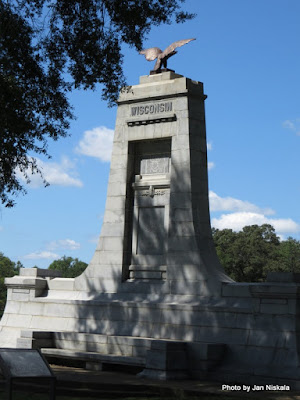The Andersonville National Historic
Site, located near Andersonville, Georgia, preserves the former Camp Sumter (also known as Andersonville Prison), a Confederate
prisoner-of-war camp during the final twelve months of the American Civil War. As well as the former prison, the site
contains the Andersonville National Cemetery and the National Prisoner of War
Museum.
The site is an iconic reminder of the horrors of Civil War prisons. It was
commanded by Captain Henry Wirz, who was tried and executed after the war for
war crimes. It was overcrowded to four times its capacity, with an inadequate
water supply, inadequate food rations, and unsanitary conditions.
Of the approximately 45,000 Union prisoners held at Camp Sumter during the war, nearly 13,000 died. The chief causes of death were scurvy, diarrhea, and dysentery. Friends provided care, food, and moral support for others in their social network, which helped prisoners survive; However, at this time in the war, Andersonville Prison was frequently under supplied with food. The Confederate Army and civilians also struggled to get enough food. The shortage was suffered by prisoners and the Confederate personnel alike within the fort. But the prisoners received less than the guards, as the latter did not suffer such emaciation, nor scurvy (caused by vitamin C deficiency). The latter was probably the main cause of mortality (along with diarrhea, caused by living in the filth from poor sanitation and the necessity to take drinking water from a creek filled at all times with fecal material from thousands of sick and dying men). Even when sufficient quantities of supplies were available, they were of poor quality and poorly prepared.
Of the approximately 45,000 Union prisoners held at Camp Sumter during the war, nearly 13,000 died. The chief causes of death were scurvy, diarrhea, and dysentery. Friends provided care, food, and moral support for others in their social network, which helped prisoners survive; However, at this time in the war, Andersonville Prison was frequently under supplied with food. The Confederate Army and civilians also struggled to get enough food. The shortage was suffered by prisoners and the Confederate personnel alike within the fort. But the prisoners received less than the guards, as the latter did not suffer such emaciation, nor scurvy (caused by vitamin C deficiency). The latter was probably the main cause of mortality (along with diarrhea, caused by living in the filth from poor sanitation and the necessity to take drinking water from a creek filled at all times with fecal material from thousands of sick and dying men). Even when sufficient quantities of supplies were available, they were of poor quality and poorly prepared.
The prison, which opened in February 1864, originally covered about 16.5
acres of land enclosed by a 15-foot high stockade. In
June 1864, it was enlarged to 26.5 acres. The stockade was rectangular, of dimensions
1,620 feet by 779 feet.

There were two entrances on the west side of the stockade, known as "north entrance" and "south entrance".

A depiction of
Andersonville Prison
By John L. RansomThere were two entrances on the west side of the stockade, known as "north entrance" and "south entrance".

The Dead Line at Andersonville: A light fence known as "the dead line" was erected approximately 19 feet inside the stockade wall. It demarcated a no-man's land that kept prisoners away from the stockade wall, which was made of rough-hewn logs about 16 feet high and stakes driven into the ground. Anyone crossing or even touching this "dead line" was shot without warning by sentries in the pigeon roosts. Dead lines were also used at other prisons during the Civil War.
Recreation of Andersonville tents, with view showing the dead-line.
Although the prison was surrounded by forest, very little wood was allowed to the prisoners for warmth or cooking.
The water supply from Stockade Creek became polluted when too many Union prisoners were housed by the Confederate authorities within the prison walls. Part of the creek was used as a sink, and the men were forced to wash themselves in the creek.[Wikipedia]

Recreated "pigeon Roost" and stockade.
North Gate
South Gate

Recreation of the locks on the North and South gates.
A Description of Andersonville by Robert H. Kellogg, Sergeant Major in the 16th Regiment
Connecticut Volunteers, described his entry as a prisoner into the prison camp,
May 2, 1864:
“As we entered the
place, a spectacle met our eyes that almost froze our blood with horror, and
made our hearts fail within us. Before us were forms that had once been active
and erect;—stalwart men, now
nothing but mere walking skeletons, covered with filth and vermin. Many of our
men, in the heat and intensity of their feeling, exclaimed with earnestness.
"Can this be hell?" "God protect us!" and all thought that
He alone could bring them out alive from so terrible a place. In the center of
the whole was a swamp, occupying about three or four acres of the narrowed
limits, and a part of this marshy place had been used by the prisoners as a
sink, and excrement covered the ground, the scent arising from which was
suffocating. The ground allotted to our ninety was near the edge of this
plague-spot, and how we were to live through the warm summer weather in the
midst of such fearful surroundings, was more than we cared to think of just
then”.(Wikipedia)
Needless to say, just like any war that has ever been, the Civil War in our
own country was devastating to both sides.
If only humans could learn to sit down and talk through issues they do
not agree with, learn to listen, learn to be tolerate of the beliefs of others,
learn that, especially in this day and age, war is not the answer. If all humans could just realize how precious
life is and how short it is.
More to come soon, and I promise a happier chapter!
Jan 🌷🌷🐾🐾
























